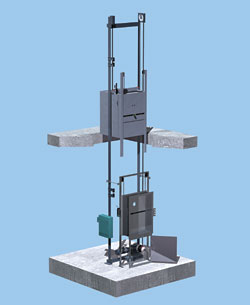Vertical Materials Handling Systems aka Dumbwaiters
Different Types of Systems: Dumbwaiters
There are two major groups of vertical material handling systems: dumbwaiters and conveyors.
Dumbwaiters are restricted in size of platform (10.75 square feet) and clear inside height (4-feet). Code regulations state they must have a minimum capacity of 13.9 lbs. per cu. ft of internal area, but no maximum capacity; they are, however, generally built with a capacity of 100 lbs. to 500 lbs. They are usually enclosed within a fire-rated hoistway or shaft and equipped with fire-rated hoistway entrances. They can be equipped with power operated hoistway entrances and automatic loading and unloading conveyors at landings. They can also stop at floor level for the transport of wheeled carts or at table or counter height for hand loading. Dumbwaiters are allowed by code to have machines within and adjacent to the hoistway. They are regulated by the elevator code (ANSI 17.1).
Depending upon requirements of speed, capacity and travel distance, dumbwaiters use one of two types of hoisting mechanisms: winding drum and traction. Thewinding drum dumbwaiter raises and lowers the car by wrapping and unwrapping the hoist rope on cylindrical steel grooved drum located at the top or bottom of the lift shaft.
- Ideally suited for heavy-duty use in medium or low-rise applications.
- Maximum speed of 50 feet per minute.
- Capacity is usually 100 lbs. to 500 lbs.
- Height limitation is usually 50 feet. Larger travel distances are possible with custom design.
- Space required above the car at upper landing usually varies between 42-inches and 60-inches if the machine is located at the top. Space required at upper landing if the machine is located below depends upon the height and type of entrance door used.
- Car dimensions can vary according to client needs.
- Machines for floor loading dumbwaiters are mostly located at the top, but in some situations such as clean rooms, can be located at lower landings adjacent to and at the sides of the hoistway. Machines for counter-height loading dumbwaiters may be located inside the hoistway and below the counter-height.
- Its heavy-duty guide rails can span 12-feet floor heights without requiring intermediate brackets or tower support, allowing the use of lightweight, non-load bearing shaft walls.
- Hoistway clearances (see diagram A)
- An ideal choice for adding onto existing structures.
- The least expensive system with minimal maintenance.
|
Thetraction dumbwaiter machine, commonly located at the top of the lift shaft, turns a pulley called a traction sheave. Hoist cables run over the top of the sheave and drop on one side to the car and on the other side to a counterweight. When the car goes up, the counterweight goes down, and vice versa. The use of a counterweight allows less energy to be expended.
- Usually used in higher rise and higher speed applications.
- Speed is 50 to 300 feet per minute.
- Capacity is usually 100 lbs. to 500 lbs., but can accommodate more.
- Machines are mostly located at the top, but, in some situations
such as clean rooms, can be located at lower landings adjacent
and at the sides of the hoistway.
- Space required above the car at upper landing varies between 48-inches and 66-inches.
- It offers floor-level loading or counter-height loading capability.
- Hoistway clearances (see Diagram A)
- Counterweighted traction design employs high-rise elevator technology. State of the art microprocessor controls allow custom programmed operations.
- More expensive than winding drum or hydraulic systems.










